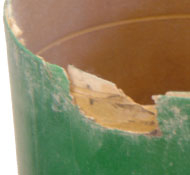watermelonman
Well-Known Member
- Joined
- Sep 22, 2014
- Messages
- 2,597
- Reaction score
- 10
I feel extremely comfortable with cardboard, wood, commercial fiberglass, and cloth. However I still have yet to work with blue tube, quantum tube, sonotube, phenolic, or canvas. In fact, I may not have even broken those down correctly. Apologues if so and please feel free to correct me.
I understand that some of these substances do not take well to epoxy and fiberglass cloth. I think that repairing phenolic with fiberglass cloth is fine? I inherited a rocket with some damage that looks an awful lot like this -

My plan was to sand down the paint, use some chunky epoxy filler, apply fiberglass cloth, then fill to smooth before painting over it all. Is that a good plan? When and where should I avoid adding fiberglass to tube damage?
I understand that some of these substances do not take well to epoxy and fiberglass cloth. I think that repairing phenolic with fiberglass cloth is fine? I inherited a rocket with some damage that looks an awful lot like this -

My plan was to sand down the paint, use some chunky epoxy filler, apply fiberglass cloth, then fill to smooth before painting over it all. Is that a good plan? When and where should I avoid adding fiberglass to tube damage?



